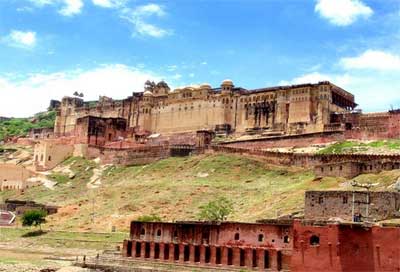 Rajasthan's beautiful Pink City Jaipur, was the stronghold of a clan of rulers whose three hill forts and series of palaces in the city areimportant attractions. Known as the Pink City because of the colour of the stone used exclusively in the walled city, Jaipur's bazaars sell embroidered leather shoes, blue pottery, tie and dye scarves and other exotic wares. Western Rajasthan itself forms a convenient circuit, in the heart of the Thar desert which has shaped its history, lifestyles and architecture.
Rajasthan's beautiful Pink City Jaipur, was the stronghold of a clan of rulers whose three hill forts and series of palaces in the city areimportant attractions. Known as the Pink City because of the colour of the stone used exclusively in the walled city, Jaipur's bazaars sell embroidered leather shoes, blue pottery, tie and dye scarves and other exotic wares. Western Rajasthan itself forms a convenient circuit, in the heart of the Thar desert which has shaped its history, lifestyles and architecture.
Jaipur has been laid according to the conventional nine-grid pattern that astrologers believe to be lucky, and which has been recommended in the ancient Indian treatise on architecture. Each grid consists of a square, and these have been planned so that, at the heart of the city is the City Palace. Spread around it, in rows, are public buildings, the residences of noblemen, the living and trading quarters of merchants and artisans. Straight, wide roads run through the city, while a high, crenellated wall that forms its defense is pierced with seven gateways that serve as entry points. Today, these walls may be more difficult to spot since the city has grown far beyond its original plan, but they are still there, proof that though Jaipur saw no great siege, it was more than adequately prepared for it.
Jaipur architectural planning may have been ancient, but its execution was definitely modern. Best represented by the City Palace complex, it brought together all that was excellent in Rajput and Mughal architecture, creating a new tradition that found wide currency over much of north India. As in the Mughal tradition, the durbar or court areas became much more open, characterised by a series of arched pavilions held on delicately crafted pillars. Ornamentation had always been a part of the state architectural heritage, now it became much more opulent. The private wings of the family also extended their entertainment areas. Since defence was no longer a primary concern, larger, more ornamental windows were built to over look the streets or courtyards outside these wings. Gardens were no longer planned within the internal courtyards only, but were added to the external vistas, and water, a basic feature of Mughal palaces and gardens, was utilised in a similar fashion, in canals and fountains.
Jaipur has much to offer visitors everything from pageants and festivals to extraordinarily clad people, a wealth of handicrafts, a royal legacy of palaces, and sightseeing that will occupy their time. However, should the visitors simply choose to walk around the streets of the old city instead, they will not regret it. All of Jaipur is an architectural gem, and no scheduled sight seeing can even hope to do justice to this rare city.
Jaipur Architecture
Jaipur Architecture is world wide famous because of its technical details and beauty. Jaipur Architecture is based on Indian Vastu concepts. Maharaja Sawai Jai Singh II – the founder of Jaipur was a great architect and astronomer. He also had a good knowledge of Indian Vastu. This is the reason that the architecture of Jaipur is a wonderful case study for the modern architects of the whole world.
Jaipur Geography and Climate
Jaipur has a semi-arid climate. Temperatures vary here in different seasons. In the summer months of April to June, average daily temperature remains around 35 degree Calcius in Jaipur. May and June are the hottest months in Jaipur. Temperature reaches up to 40-45 degree Calcius in these months.
Annually the rainfall is concentrated in the monsoon months between June (Last of June) and September. It receives over 500 mm (approx 20 inch) of rainfall an average.
Languages spoken
Hindi, Rajasthani and English to a small degree are commonly spoken in hotels and restaurants, staff speak English as well as Hindi. One can easily communicate with a minimum knowledge of Hindi or English
Jaipur Heritage
Jaipur is known as Heritage City because of its rich heritage culture, customs, traditions, fairs and festivals, civilization, and hundreds years old forts and monuments. The glorious architecture of Jaipur the Pink City is renowned across the world. Wonderful Forts and Monuments garland the entire city in a planned manner.







